


PLoS ONE 11(1):Įditor: Robert Britton, Bournemouth University, UNITED KINGDOM (2016) Fine-Scale Ecological and Genetic Population Structure of Two Whitefish (Coregoninae) Species in the Vicinity of Industrial Thermal Emissions. Thus, future research should focus on the potential impacts of thermal emissions on development and recruitment.Ĭitation: Graham CF, Eberts RL, Morgan TD, Boreham DR, Lance SL, Manzon RG, et al. In concert, ecological and genetic markers do not support the presence of an evolutionarily significant unit in the vicinity of the power plant. Microsatellite analyses of genetic population structure (F st, STRUCTURE and DAPC) indicated that fish captured at all locations in the vicinity of the power plant were part of a larger population extending beyond the study area. Isotopic niche size, a metric of resource use diversity, was 1.3- to 2.8-fold higher than reference values in some thermally affected areas, indicative of fish mixing. Niche metrics using δ 13C and δ 15N stable isotopes showed high levels of overlap (48.6 to 94.5%) in resource use by adult fish captured in areas affected by thermal effluent compared to nearby reference locations. Correspondingly, we examined fine-scale ecological and genetic population structure of two whitefish species ( Coregonus clupeaformis and Prosopium cylindraceum) on Lake Huron, Canada, in the immediate vicinity of thermal effluent from nuclear power generation. Point sources of thermal effluent may need to be managed to avoid affecting discrete populations. Thermal pollution from industrial processes can have negative impacts on the spawning and development of cold-water fish.


 0 kommentar(er)
0 kommentar(er)
